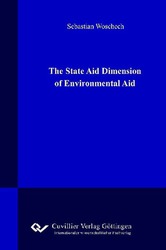| Departments | |
|---|---|
| Book Series (96) |
1378
|
| Nachhaltigkeit |
3
|
| Gesundheitswesen |
1
|
| Humanities |
2363
|
| Medienwissenschaften | 16 |
| Theology | 57 |
| Philosophy | 102 |
| Law | 422 |
| Economics | 850 |
| Social sciences | 416 |
| Sports science | 48 |
| Psychology | 233 |
| Educational science | 190 |
| History | 182 |
| Art | 110 |
| Cultural studies | 166 |
| Literary studies | 116 |
| Linguistics | 88 |
| Natural Sciences |
5406
|
| Engineering |
1791
|
| Common |
97
|
|
Leitlinien Unfallchirurgie
5. Auflage bestellen |
|
Advanced Search
The State Aid Dimension of Enviromental Aid (English shop)
Sebastian Woschech (Author)Preview
Table of Contents, Datei (43 KB)
Extract, Datei (64 KB)
The latest generation of European environmental regulation makes use of market mechanisms in order to achieve its regulatory goals. Preserving effective competition therefore is a precondition for the attainment of Europe’s ambitious environmental targets. Although State Aid is only the „second best“ option to achieve optimal allocation of resources it can be necessary to correct market failures and to pursue non-economic objectives that cannot be achieved by market forces alone. This book trails this thin line of necessity and sets out to answer the questions which arise at the borderline between competition and State Aid: Where is the border between setting the right incentives for environmental protection and distorting competition? When do exemptions from environmental regulation undermine competition and therefore frustrate their very objective? Are all market based instruments deployed by the EU compatible with competition in general and State Aid regulation in particular?
Looking at these questions the tension between competition, State Aid and environmental protection seems obvious. Nevertheless this book sets out to answer the question as to how all of these goals can be integrated without subordinating the one or the other.
The first part of the book places the European Environmental Policy into the State Aid context, nationally as well as internationally (part B). After a short introduction into the concept of Environmental Aid in general (part C) greater emphasis is placed on the State Aid implications of Aid for renewable energy resources (part D). It is argued, that the Altmark-judgement should be applied to public payments in the field of renewable energies and that these payments should be calculated on the basis of external costs. After dealing with the State Aid implications of environmental taxation (part E) the author conducts a detailed analysis of the current and prospective European Emission Trading System (part F).
Due to its two-step approach the book provides an easily accessible introduction (part A-C) to the field of environmental aid. However, and more importantly, the second part of the book (part D-F) provides food for thought even for those that deal with environmental aid on a regular basis, be it lawyers, legislators or scholars.
| ISBN-13 (Printausgabe) | 3867278598 |
| ISBN-13 (Hard Copy) | 9783867278591 |
| ISBN-13 (eBook) | 9783736928596 |
| Language | English |
| Page Number | 94 |
| Edition | 1 Aufl. |
| Volume | 0 |
| Publication Place | Göttingen |
| Publication Date | 2009-01-21 |
| General Categorization | Master's thesis |
| Departments |
Law
|
| Keywords | Environmental Aid, State Aid, Environmental Regulation, Environmental Targets, History of Environmental Regulation, Market Mechanisms, Environmental Policy, Justification for State Aid, Environmental Guidelines, General Block Exemption Regulation, Aid for renewable Energy sources, PreussenElektra, feed-in Tariffs, Green Certificates, External Costs, Aid calculated on the basis of External costs, Altmark, Environmental Taxation, eco-tax exemptions, Art. 87 EC, EU-ETS, European Emission Trading System, Emission Trading System, tradable permit schemes, National Allocation Plans, distortion of competition, Review of the EU-ETS. |








